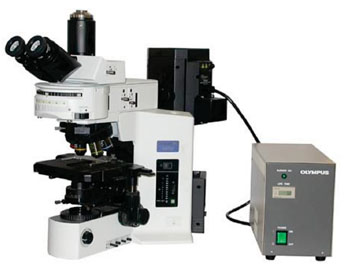Blood-Based Diagnostic Determines Hormonal Status of Metastatic Breast Cancer Patients
|
By LabMedica International staff writers Posted on 11 Mar 2015 |

Image: Immunohistochemistry of formalin fixed paraffin-embedded sections from breast carcinoma stained with Estrogen Receptor alpha antibody (Photo courtesy of Abcam).

Image: Olympus Bx51 fluorescent microscope (Photo courtesy of Washington University in St. Louis).
Estrogen receptor (ER) and progesterone receptor (PR) status is prognostic and predictive in breast cancer and because metastatic breast tumor biopsies are not routinely feasible, circulating tumor cells offer an alternative source of determining ER/PR tumor status.
Circulating tumor cells (CTCs) are commonly identified in greater than 50 % of metastatic breast cancer, with enumeration demonstrating predictive implications in disease progression in patients receiving chemotherapy or endocrine therapy.
Scientists at the College of Physicians and Surgeons, Columbia University (New York, NY, USA) working with a proprietary CTC isolation platform, prospectively define hormonal status (ER/PR) using a peripheral blood sample in 36 women with metastatic breast cancer. The patients who had histologically proven stage IV invasive breast cancer were enrolled from January 2011 to June 2012. Patients were allowed to be receiving anti-estrogen treatment, chemotherapy, and/or biologic therapy.
CTCs were isolated using the microfluidic OncoCEE platform (Biocept Inc.; San Diego, CA, USA). Detection was accomplished with an expanded anti-cytokeratin (CK) cocktail mixture and anti-CD45. ER/PR protein expression was assessed by immunocytochemistry (ICC) on the CK+ cells and compared to the primary and/or metastatic tumor by immunohistochemistry (IHC). The microchannels underwent immediate manual microscopic analysis for enumeration of CTCs and assessment of ER/PR followed by taking images and X/Y coordinates recorded using Olympus Bx51 fluorescent microscopes (Olympus America; Center Valley, PA, USA) equipped with appropriate filters.
Among the 24 CK + CTC cases, a concordance of 68 % (15/22) in ER/PR status between primary breast tumor and CTCs and 83 % (10/12) between metastatic tumor and CTCs was observed. An overall concordance of 79% (19/24) was achieved when assessing CTC and metastatic tumor with the primary tumor substituted if metastatic breast biopsy not available. A test sensitivity of 72% and specificity of 100% was identified when comparing CTCs to tumor tissue. Of the seven discordant cases between CTCs and primary tumor tissue, two were concordant with the metastatic biopsy.
The authors concluded that heterogeneity of ER/PR protein expression is identified in CTCs, and primary tumor/metastatic biopsy material and hormonal status may change over time due to therapy. ER/PR ICC on CTCs from peripheral blood using the OncoCEE platform is shown to be feasible, with high concordance in ER/PR status between primary tumor/metastatic biopsy (by IHC) and CTCs (by ICC). The study was published on January 25, 2015, in the journal Clinical and Translational Oncology.
Related Links:
College of Physicians and Surgeons
Biocept Inc.
Olympus America
Circulating tumor cells (CTCs) are commonly identified in greater than 50 % of metastatic breast cancer, with enumeration demonstrating predictive implications in disease progression in patients receiving chemotherapy or endocrine therapy.
Scientists at the College of Physicians and Surgeons, Columbia University (New York, NY, USA) working with a proprietary CTC isolation platform, prospectively define hormonal status (ER/PR) using a peripheral blood sample in 36 women with metastatic breast cancer. The patients who had histologically proven stage IV invasive breast cancer were enrolled from January 2011 to June 2012. Patients were allowed to be receiving anti-estrogen treatment, chemotherapy, and/or biologic therapy.
CTCs were isolated using the microfluidic OncoCEE platform (Biocept Inc.; San Diego, CA, USA). Detection was accomplished with an expanded anti-cytokeratin (CK) cocktail mixture and anti-CD45. ER/PR protein expression was assessed by immunocytochemistry (ICC) on the CK+ cells and compared to the primary and/or metastatic tumor by immunohistochemistry (IHC). The microchannels underwent immediate manual microscopic analysis for enumeration of CTCs and assessment of ER/PR followed by taking images and X/Y coordinates recorded using Olympus Bx51 fluorescent microscopes (Olympus America; Center Valley, PA, USA) equipped with appropriate filters.
Among the 24 CK + CTC cases, a concordance of 68 % (15/22) in ER/PR status between primary breast tumor and CTCs and 83 % (10/12) between metastatic tumor and CTCs was observed. An overall concordance of 79% (19/24) was achieved when assessing CTC and metastatic tumor with the primary tumor substituted if metastatic breast biopsy not available. A test sensitivity of 72% and specificity of 100% was identified when comparing CTCs to tumor tissue. Of the seven discordant cases between CTCs and primary tumor tissue, two were concordant with the metastatic biopsy.
The authors concluded that heterogeneity of ER/PR protein expression is identified in CTCs, and primary tumor/metastatic biopsy material and hormonal status may change over time due to therapy. ER/PR ICC on CTCs from peripheral blood using the OncoCEE platform is shown to be feasible, with high concordance in ER/PR status between primary tumor/metastatic biopsy (by IHC) and CTCs (by ICC). The study was published on January 25, 2015, in the journal Clinical and Translational Oncology.
Related Links:
College of Physicians and Surgeons
Biocept Inc.
Olympus America
Latest Technology News
- New Diagnostic System Achieves PCR Testing Accuracy
- DNA Biosensor Enables Early Diagnosis of Cervical Cancer
- Self-Heating Microfluidic Devices Can Detect Diseases in Tiny Blood or Fluid Samples
- Breakthrough in Diagnostic Technology Could Make On-The-Spot Testing Widely Accessible
- First of Its Kind Technology Detects Glucose in Human Saliva
- Electrochemical Device Identifies People at Higher Risk for Osteoporosis Using Single Blood Drop
- Novel Noninvasive Test Detects Malaria Infection without Blood Sample
- Portable Optofluidic Sensing Devices Could Simultaneously Perform Variety of Medical Tests
- Point-of-Care Software Solution Helps Manage Disparate POCT Scenarios across Patient Testing Locations
- Electronic Biosensor Detects Biomarkers in Whole Blood Samples without Addition of Reagents
- Breakthrough Test Detects Biological Markers Related to Wider Variety of Cancers
- Rapid POC Sensing Kit to Determine Gut Health from Blood Serum and Stool Samples
- Device Converts Smartphone into Fluorescence Microscope for Just USD 50
- Wi-Fi Enabled Handheld Tube Reader Designed for Easy Portability
Channels
Clinical Chemistry
view channel
3D Printed Point-Of-Care Mass Spectrometer Outperforms State-Of-The-Art Models
Mass spectrometry is a precise technique for identifying the chemical components of a sample and has significant potential for monitoring chronic illness health states, such as measuring hormone levels... Read more.jpg)
POC Biomedical Test Spins Water Droplet Using Sound Waves for Cancer Detection
Exosomes, tiny cellular bioparticles carrying a specific set of proteins, lipids, and genetic materials, play a crucial role in cell communication and hold promise for non-invasive diagnostics.... Read more
Highly Reliable Cell-Based Assay Enables Accurate Diagnosis of Endocrine Diseases
The conventional methods for measuring free cortisol, the body's stress hormone, from blood or saliva are quite demanding and require sample processing. The most common method, therefore, involves collecting... Read moreMolecular Diagnostics
view channelBlood Proteins Could Warn of Cancer Seven Years before Diagnosis
Two studies have identified proteins in the blood that could potentially alert individuals to the presence of cancer more than seven years before the disease is clinically diagnosed. Researchers found... Read moreUltrasound-Aided Blood Testing Detects Cancer Biomarkers from Cells
Ultrasound imaging serves as a noninvasive method to locate and monitor cancerous tumors effectively. However, crucial details about the cancer, such as the specific types of cells and genetic mutations... Read moreHematology
view channel
Next Generation Instrument Screens for Hemoglobin Disorders in Newborns
Hemoglobinopathies, the most widespread inherited conditions globally, affect about 7% of the population as carriers, with 2.7% of newborns being born with these conditions. The spectrum of clinical manifestations... Read more
First 4-in-1 Nucleic Acid Test for Arbovirus Screening to Reduce Risk of Transfusion-Transmitted Infections
Arboviruses represent an emerging global health threat, exacerbated by climate change and increased international travel that is facilitating their spread across new regions. Chikungunya, dengue, West... Read more
POC Finger-Prick Blood Test Determines Risk of Neutropenic Sepsis in Patients Undergoing Chemotherapy
Neutropenia, a decrease in neutrophils (a type of white blood cell crucial for fighting infections), is a frequent side effect of certain cancer treatments. This condition elevates the risk of infections,... Read more
First Affordable and Rapid Test for Beta Thalassemia Demonstrates 99% Diagnostic Accuracy
Hemoglobin disorders rank as some of the most prevalent monogenic diseases globally. Among various hemoglobin disorders, beta thalassemia, a hereditary blood disorder, affects about 1.5% of the world's... Read moreImmunology
view channel.jpg)
AI Predicts Tumor-Killing Cells with High Accuracy
Cellular immunotherapy involves extracting immune cells from a patient's tumor, potentially enhancing their cancer-fighting capabilities through engineering, and then expanding and reintroducing them into the body.... Read more
Diagnostic Blood Test for Cellular Rejection after Organ Transplant Could Replace Surgical Biopsies
Transplanted organs constantly face the risk of being rejected by the recipient's immune system which differentiates self from non-self using T cells and B cells. T cells are commonly associated with acute... Read more
AI Tool Precisely Matches Cancer Drugs to Patients Using Information from Each Tumor Cell
Current strategies for matching cancer patients with specific treatments often depend on bulk sequencing of tumor DNA and RNA, which provides an average profile from all cells within a tumor sample.... Read more
Genetic Testing Combined With Personalized Drug Screening On Tumor Samples to Revolutionize Cancer Treatment
Cancer treatment typically adheres to a standard of care—established, statistically validated regimens that are effective for the majority of patients. However, the disease’s inherent variability means... Read moreMicrobiology
view channel
Integrated Solution Ushers New Era of Automated Tuberculosis Testing
Tuberculosis (TB) is responsible for 1.3 million deaths every year, positioning it as one of the top killers globally due to a single infectious agent. In 2022, around 10.6 million people were diagnosed... Read more
Automated Sepsis Test System Enables Rapid Diagnosis for Patients with Severe Bloodstream Infections
Sepsis affects up to 50 million people globally each year, with bacteraemia, formerly known as blood poisoning, being a major cause. In the United States alone, approximately two million individuals are... Read moreEnhanced Rapid Syndromic Molecular Diagnostic Solution Detects Broad Range of Infectious Diseases
GenMark Diagnostics (Carlsbad, CA, USA), a member of the Roche Group (Basel, Switzerland), has rebranded its ePlex® system as the cobas eplex system. This rebranding under the globally renowned cobas name... Read more
Clinical Decision Support Software a Game-Changer in Antimicrobial Resistance Battle
Antimicrobial resistance (AMR) is a serious global public health concern that claims millions of lives every year. It primarily results from the inappropriate and excessive use of antibiotics, which reduces... Read moreTechnology
view channel
New Diagnostic System Achieves PCR Testing Accuracy
While PCR tests are the gold standard of accuracy for virology testing, they come with limitations such as complexity, the need for skilled lab operators, and longer result times. They also require complex... Read more
DNA Biosensor Enables Early Diagnosis of Cervical Cancer
Molybdenum disulfide (MoS2), recognized for its potential to form two-dimensional nanosheets like graphene, is a material that's increasingly catching the eye of the scientific community.... Read more
Self-Heating Microfluidic Devices Can Detect Diseases in Tiny Blood or Fluid Samples
Microfluidics, which are miniature devices that control the flow of liquids and facilitate chemical reactions, play a key role in disease detection from small samples of blood or other fluids.... Read more
Breakthrough in Diagnostic Technology Could Make On-The-Spot Testing Widely Accessible
Home testing gained significant importance during the COVID-19 pandemic, yet the availability of rapid tests is limited, and most of them can only drive one liquid across the strip, leading to continued... Read moreIndustry
view channel
Danaher and Johns Hopkins University Collaborate to Improve Neurological Diagnosis
Unlike severe traumatic brain injury (TBI), mild TBI often does not show clear correlations with abnormalities detected through head computed tomography (CT) scans. Consequently, there is a pressing need... Read more
Beckman Coulter and MeMed Expand Host Immune Response Diagnostics Partnership
Beckman Coulter Diagnostics (Brea, CA, USA) and MeMed BV (Haifa, Israel) have expanded their host immune response diagnostics partnership. Beckman Coulter is now an authorized distributor of the MeMed... Read more_1.jpg)












_1.jpg)
.jpg)
